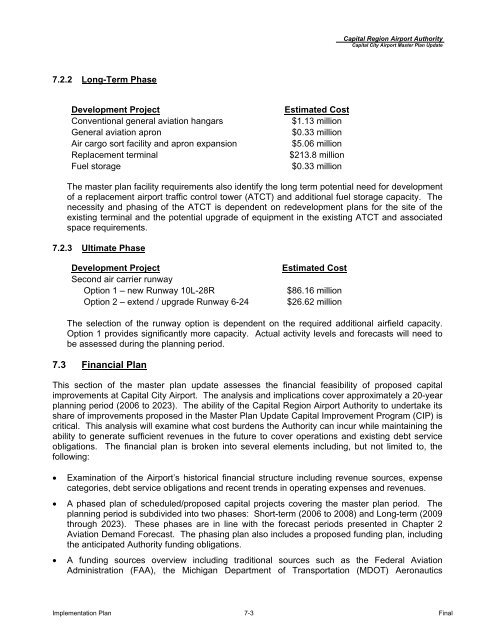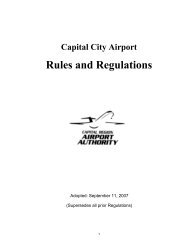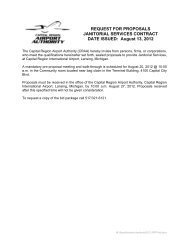Master Plan Update (pdf) - Lansing/Capital City Airport
Master Plan Update (pdf) - Lansing/Capital City Airport
Master Plan Update (pdf) - Lansing/Capital City Airport
Create successful ePaper yourself
Turn your PDF publications into a flip-book with our unique Google optimized e-Paper software.
7.2.2 Long-Term Phase<br />
Development Project Estimated Cost<br />
Conventional general aviation hangars $1.13 million<br />
General aviation apron $0.33 million<br />
Air cargo sort facility and apron expansion $5.06 million<br />
Replacement terminal $213.8 million<br />
Fuel storage $0.33 million<br />
<strong>Capital</strong> Region <strong>Airport</strong> Authority<br />
<strong>Capital</strong> <strong>City</strong> <strong>Airport</strong> <strong>Master</strong> <strong>Plan</strong> <strong>Update</strong><br />
The master plan facility requirements also identify the long term potential need for development<br />
of a replacement airport traffic control tower (ATCT) and additional fuel storage capacity. The<br />
necessity and phasing of the ATCT is dependent on redevelopment plans for the site of the<br />
existing terminal and the potential upgrade of equipment in the existing ATCT and associated<br />
space requirements.<br />
7.2.3 Ultimate Phase<br />
Development Project Estimated Cost<br />
Second air carrier runway<br />
Option 1 – new Runway 10L-28R $86.16 million<br />
Option 2 – extend / upgrade Runway 6-24 $26.62 million<br />
The selection of the runway option is dependent on the required additional airfield capacity.<br />
Option 1 provides significantly more capacity. Actual activity levels and forecasts will need to<br />
be assessed during the planning period.<br />
7.3 Financial <strong>Plan</strong><br />
This section of the master plan update assesses the financial feasibility of proposed capital<br />
improvements at <strong>Capital</strong> <strong>City</strong> <strong>Airport</strong>. The analysis and implications cover approximately a 20-year<br />
planning period (2006 to 2023). The ability of the <strong>Capital</strong> Region <strong>Airport</strong> Authority to undertake its<br />
share of improvements proposed in the <strong>Master</strong> <strong>Plan</strong> <strong>Update</strong> <strong>Capital</strong> Improvement Program (CIP) is<br />
critical. This analysis will examine what cost burdens the Authority can incur while maintaining the<br />
ability to generate sufficient revenues in the future to cover operations and existing debt service<br />
obligations. The financial plan is broken into several elements including, but not limited to, the<br />
following:<br />
• Examination of the <strong>Airport</strong>’s historical financial structure including revenue sources, expense<br />
categories, debt service obligations and recent trends in operating expenses and revenues.<br />
• A phased plan of scheduled/proposed capital projects covering the master plan period. The<br />
planning period is subdivided into two phases: Short-term (2006 to 2008) and Long-term (2009<br />
through 2023). These phases are in line with the forecast periods presented in Chapter 2<br />
Aviation Demand Forecast. The phasing plan also includes a proposed funding plan, including<br />
the anticipated Authority funding obligations.<br />
• A funding sources overview including traditional sources such as the Federal Aviation<br />
Administration (FAA), the Michigan Department of Transportation (MDOT) Aeronautics<br />
Implementation <strong>Plan</strong> 7-3 Final




